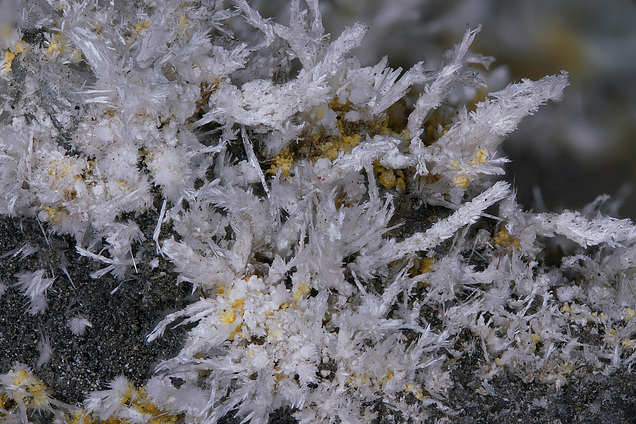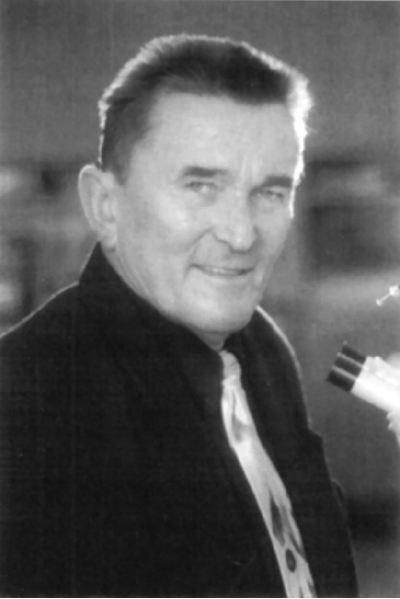Bouškaite
A valid IMA mineral species
This page is currently not sponsored. Click here to sponsor this page.
About Bouškaite
Formula:
(MoO2)2O(SO3OH)2(H2O)4
Colour:
Colorless to light beige
Lustre:
Vitreous
Hardness:
2
Specific Gravity:
2.40
Crystal System:
Triclinic
Name:
Named in honor of Vladimír Bouška (11 April 1933, Horusice u Veselí nad Lužnicí - 24 July 2000, Prague, Czech Republic), mineralogist, geochemist, and professor at Charles University, Prague, Czech Republic. He wrote hundreds of papers on varying topics of mineralogy and related fields. He was also an authority on natural glass.
New structure type. The first molybdenum sulfate mineral (but not unique chemical combination). Second molybdenyl-bearing mineral after vajdakite (the third species is hasanovite - another molybdenyl sulfate mineral).
Also compare the chemically similar liangjunite, novikovite, and vanpeltite.
Also compare the chemically similar liangjunite, novikovite, and vanpeltite.
Unique Identifiers
Mindat ID:
53373
Long-form identifier:
mindat:1:1:53373:5
GUID
(UUID V4):
(UUID V4):
57c3bff0-a6bf-4420-8813-b5a270c97c72
IMA Classification of Bouškaite
Approved
IMA Formula:
(MoO2)2O(SO3OH)2(H2O)2 · 2H2O
Approval year:
2019
First published:
2019
Classification of Bouškaite
7.DE.50
7 : SULFATES (selenates, tellurates, chromates, molybdates, wolframates)
D : Sulfates (selenates, etc.) with additional anions, with H2O
E : With only medium-sized cations; unclassified
7 : SULFATES (selenates, tellurates, chromates, molybdates, wolframates)
D : Sulfates (selenates, etc.) with additional anions, with H2O
E : With only medium-sized cations; unclassified
Mineral Symbols
As of 2021 there are now IMA–CNMNC approved mineral symbols (abbreviations) for each mineral species, useful for tables and diagrams.
| Symbol | Source | Reference |
|---|---|---|
| Bok | IMA–CNMNC | Warr, L.N. (2021). IMA–CNMNC approved mineral symbols. Mineralogical Magazine, 85(3), 291-320. doi:10.1180/mgm.2021.43 |
Physical Properties of Bouškaite
Vitreous
Transparency:
Transparent, Translucent
Colour:
Colorless to light beige
Streak:
White to light grey
Hardness:
2 on Mohs scale
Tenacity:
Brittle
Cleavage:
Perfect
On {001}
On {001}
Fracture:
Irregular/Uneven
Comment:
Thin blades (fibers) are somewhat flexible
Density:
2.40(2) g/cm3 (Measured) 2.38 g/cm3 (Calculated)
Optical Data of Bouškaite
Type:
Biaxial (+)
RI values:
nα = 1.504(2) nβ = 1.605(2) nγ = 1.705(3)
2V:
Measured: 82° (1), Calculated: 82.05°
Max Birefringence:
δ = 0.201

Image shows birefringence interference colour range (at 30µm thickness)
and does not take into account mineral colouration.
and does not take into account mineral colouration.
Surface Relief:
Moderate
Dispersion:
Moderate, r > v
Pleochroism:
Non-pleochroic
Comments:
X∧c = 24°; Y∧a = 20°; Z∧b = 16°.
Chemistry of Bouškaite
Mindat Formula:
(MoO2)2O(SO3OH)2(H2O)4
Elements listed:
Crystallography of Bouškaite
Crystal System:
Triclinic
Class (H-M):
1 - Pinacoidal
Space Group:
P1
Cell Parameters:
a = 5.581(3) Å, b = 9.572(1) Å, c = 14.425(4) Å
α = 97.43(1)°, β = 100.05(2)°, γ = 89.96(1)°
α = 97.43(1)°, β = 100.05(2)°, γ = 89.96(1)°
Ratio:
a:b:c = 0.583 : 1 : 1.507
Unit Cell V:
752.2 ų
Z:
2
Morphology:
Flattened on {001} and elongated along [100]. The dominant form is {001}; other likely forms include prisms built from the pinacoids {010}, {011} and {01-1} and pinacoids {100} and {10-1}.
X-Ray Powder Diffraction
Powder Diffraction Data:
| d-spacing | Intensity |
|---|---|
| 14.15 Å | (35) |
| 7.078 Å | (100) |
| 5.483 Å | (6) |
| 5.440 Å | (9) |
| 4.838 Å | (7) |
| 4.720 Å | (56) |
| 4.010 Å | (7) |
| 3.240 Å | (10) |
Geological Environment
Paragenetic Mode(s):
| Paragenetic Mode | Earliest Age (Ga) |
|---|---|
| Stage 7: Great Oxidation Event | <2.4 |
| 47a : [Near-surface hydration of prior minerals] | |
| 47b : [Sulfates and sulfites] |
Type Occurrence of Bouškaite
General Appearance of Type Material:
Randomly or radially arranged fibers up to 7 mm in length formed by multiple sub-parallel intergrowths of very narrow blades on weathered quartz gangue.
Place of Conservation of Type Material:
Collections of (1) the Department of Mineralogy and Petrology, National Museum Prague, Cirkusová 1740, CZ-193 00 Praha 9, Czech Republic, catalogue number P1P 24/2018 (holotype), and (2) the Natural History Museum of Los Angeles County, 900 Exposition Boulevard, Los Angeles, CA 90007, USA, catalogue number 66776 (cotype)
Geological Setting of Type Material:
Supergene mineral, probably relatively recently formed in the relatively dry parts of the mine dump material by weathering of primary jordisite and pyrite.
Reference:
Sejkora, J., Grey, I.E., Kampf, A.R., Plášil, J. and Škácha, P. (2019) Bouškaite, a new molybdenyl-hydrogensulfate mineral, (MoO2)2O(SO3OH)2(H2O)2·2H2O, from the Lill mine, Příbram ore area, Czech Republic. Journal of Geosciences: 64: 197-205.
Synonyms of Bouškaite
Common Associates
Related Minerals - Strunz-mindat Grouping
| 7.DE. | Cossaite | (Mg0.5,◻)Al6(SO4)6(HSO4)F6 · 36H2O |
| 7.DE. | Magnesioalterite | Mg2Fe3+4(SO4)4(C2O4)2(OH)4 · 17H2O |
| 7.DE. | Liangjunite | K2(Mo2O5)(SO4)2 · 3H2O |
| 7.DE. | Fabritzite | Zn9(SO4)2(OH)12Cl2 · 6H2O |
| 7.DE. | Downsite | K2(MoO3)3(SO4) · 4H2O |
| 7.DE.05 | Mangazeite | Al2(SO4)(OH)4 · 3H2O |
| 7.DE.10 | Carbonatecyanotrichite | Cu4Al2(CO3,SO4)(OH)12 · 2H2O |
| 7.DE.10 | Cyanotrichite | Cu4Al2(SO4)(OH)12 · 2H2O |
| 7.DE.10 | UKI-1975-(SO:AlCu) | (Cu, Al, SO4, H2O) |
| 7.DE.15 | Schwertmannite | Fe3+16(OH,SO4)12-13O16 · 10-12H2O |
| 7.DE.20 | Tlalocite | Cu10Zn6(Te6+O4)2(Te4+O3)(OH)25Cl · 27H2O |
| 7.DE.25 | Utahite | MgCu4Zn2Te6+3O14(OH)4 · 6H2O |
| 7.DE.35 | Coquandite | Sb6+xO8+x(SO4)(OH)x(H2O)1- x (x = 0.3) |
| 7.DE.40 | Osakaite | Zn4(SO4)(OH)6 · 5H2O |
| 7.DE.42 | Alterite | Zn2Fe3+4(SO4)4(C2O4)2(OH)4 · 17H2O |
| 7.DE.45 | Wilcoxite | MgAl(SO4)2F · 17H2O |
| 7.DE.45 | Barrotite | Cu9Al(HSiO4)2[(SO4)(HAsO4)0.5](OH)12 · 8H2O |
| 7.DE.47 | Tiberiobardiite | {Cu9Al[SiO3(OH)]2(OH)12(H2O)6}(SO4)1.5 · 10H2O |
| 7.DE.50 | Stanleyite | (V4+O)(SO4) · 6H2O |
| 7.DE.57 | Khangalasite | Fe(SO4)(OH) · 2H2O |
| 7.DE.60 | Hydrobasaluminite | Al4(SO4)(OH)10 · 12-36H2O |
| 7.DE.62 | Volaschioite | Fe4(SO4)O2(OH)6 · 2H2O |
| 7.DE.65 | Zaherite | Al12(SO4)5(OH)26 · 20H2O |
| 7.DE.75 | Camérolaite | Cu6Al3(OH)18(H2O)2[Sb(OH)6](SO4) |
Fluorescence of Bouškaite
Does not fluoresce under either short- or long-wave ultraviolet light.
Other Information
Health Risks:
No information on health risks for this material has been entered into the database. You should always treat mineral specimens with care.
Internet Links for Bouškaite
mindat.org URL:
https://www.mindat.org/min-53373.html
Please feel free to link to this page.
Please feel free to link to this page.
Search Engines:
External Links:
Mineral Dealers:
References for Bouškaite
Localities for Bouškaite
Locality List
 - This locality has map coordinates listed.
- This locality has map coordinates listed.
 - This locality has estimated coordinates.
ⓘ - Click for references and further information on this occurrence.
? - Indicates mineral may be doubtful at this locality.
- This locality has estimated coordinates.
ⓘ - Click for references and further information on this occurrence.
? - Indicates mineral may be doubtful at this locality.
 - Good crystals or important locality for species.
- Good crystals or important locality for species.
 - World class for species or very significant.
(TL) - Type Locality for a valid mineral species.
(FRL) - First Recorded Locality for everything else (eg varieties).
- World class for species or very significant.
(TL) - Type Locality for a valid mineral species.
(FRL) - First Recorded Locality for everything else (eg varieties).
All localities listed without proper references should be considered as questionable.
Czech Republic | |
| Sejkora et al. (2020) |
| European Journal of Mineralogy: 31: ... +1 other reference | |
USA | |
| Yang et al. (2023) |
Quick NavTopAbout BouškaiteUnique IdentifiersIMA Classification Classification Mineral SymbolsPhysical Properties Optical Data Chemistry Crystallography X-Ray Powder DiffractionGeological EnvironmentType Occurrence SynonymsCommon AssociatesStrunz-MindatFluorescence Other InformationInternet Links References Localities Locality List



 symbol to view information about a locality.
The
symbol to view information about a locality.
The 



Mine dump, Lill Mine, Černojamské deposit, Březové Hory, Příbram, Příbram District, Central Bohemian Region, Czech Republic